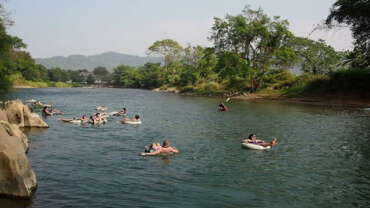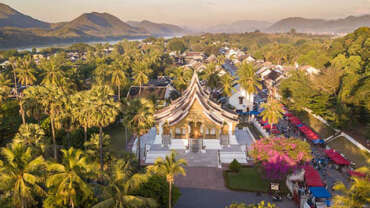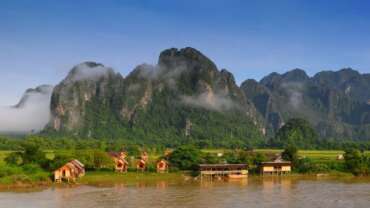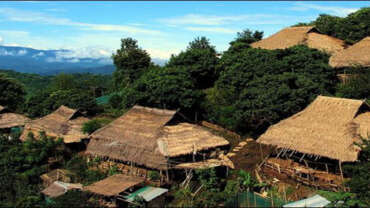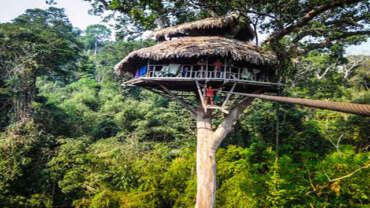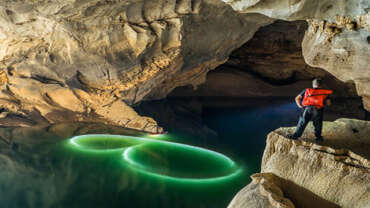Explore Laos!
Vientiane is the capital of Laos and considered to be the smallest capital in Southeast Asia with a population of about 600 000 (2007 est.). Vientiane is also known as the City of the Sandalwood. It is the largest city in Laos situated along the curve of Mekong River.
The city’s places of interest are concentrated in a small area in the commercial district and can easily be explored on foot. The city offers a laid back paced of life; traffic is lighter compared to other Southeast Asian cities, less modern infrastructures presenting a relaxing cosy feeling. Vientiane was declared capital of the country in the early 16th century, taking status from the more imperial and influential city of Luang Prabang.
During the early 19th century when King Anouvong raised an unsuccessful rebellion, the city of Vientiane was conquered and sacked by the Siamese army. When the city became a French protectorate in the late 19th century Vientiane was rebuilt and the Buddhist temples were repaired.
One of the most prominent landmarks of Vientiane is the Patuxai or Victory Monument. It is a huge monument on Lang Xang Avenue which resembles Paris’ Arc de Triomphe. The ceiling of the arc is elaborated by kinnari figurines painted in bright colors. The monument commemorates those who died in the pre-Communist wars. The monument was built in 1969 with US financed cement that was meant to be used for the construction of the new airport. Beneath the arch is a doorway with a staircase leading to the top of the monument. The top of the monument offers a panoramic view of the city.
Pha That Luang is also known as the Great Stupa is situated on the eastern outskirts of Vientiane. The stupa was established built in 1566 during the reign of King Setthathirat. It was built on the location of the older stupa believed to confine the relic of Buddha. Pha That Luang is a 45-meter high structure that was ravaged several times by foreign invaders. In 1930 the stupa that was heavily damaged and abandoned after the Thai invasion in 1828 was restored to its original design based on the detailed drawing of French architecture and explorer Louis Delaporte.
The architecture of the stupa includes many references to Lao culture and identity. That Luang is a major attraction tourist and had become the symbol of Lao nationalism. Consisting of three levels, each level conveys a reflection of part of the Buddhist doctrine. The 279 feet long encircling walls contain various Khmer and Lao sculptures including one of Jayavarman VII. During sunset when the sun is shrinking in the west, the stupa is glimmerings like a magnificent golden orb.
Vat Si Saket built in 1818 by King Chao Anou is considered to be the oldest surviving temple in Vientiane. Located on the corner of Lane Xang Avenue and Setthathirat Road, Vat Si Saket houses 6840 Buddha statues and figures. The temple was built in Siamese style Buddhist architecture; its ordination hall ceiling is adorned by floral paintings. The interior of the temple walls are thousands of small niches carrying a small Buddha statue and figures, while in front of the niches are huge Buddha statues made of ceramic, gold, silver and wood.
Opposite Vat Si Saket is Ho Phra Keo, popularly known as the former Temple of Emerald Buddha. Constructed by King Setthathirat in 1565 to serve as a royal temple and house the Emerald Buddha statue which was brought from Chiang Mai. The original temple was ruined during Siamese invasion and was rebuilt in 1936. It is now used as a museum showcasing extensive collections of Buddhist artifacts in the country. Ho Phra Keo is renowned for enfolding the original pillar of Vientiane which spread deep into the ground under the altar.
Situated 24 km south of Vientiane is the Buddha Park or Xieng Khun. The park is filled with large concrete statues of deities from Hindu-Buddhist pantheon and Buddha images including the 40 m reclining Buddha.
In 1958 Luang Pu Bunleua Sulilat a priest-shaman built a sculpture park in which Hinduism and Buddhism were integrated. The most unusual structure within the park is the giant pumpkin with a dead tree sticking out its top. This three-story sculpture is a reflection of the idea of earth, heaven and hell.
Other attractions that can be seen in the Vientiane are the Presidential Palace, positioned at the intersection of Lane Xang and Setthathirat Avenue. This palace was built by the French colonial governor and served as a royal residence during the reign of King Sisavangvong. Talat Sao (morning market) consists of three main building in the center of the town opposite the post office and central bus station. The market offers a vast range of durable goods such as jewelry, handicrafts and textiles.
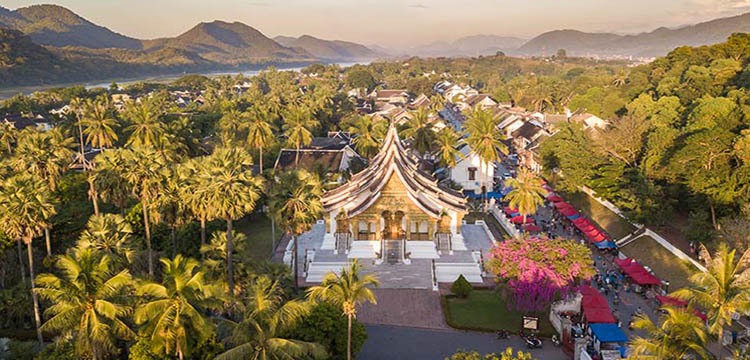
Luang Prabang
Luang Prabang is located in North Central Laos, about 428 km north of Vientiane. The city is situated on a peninsula formed by the Mekong River and its tributaries in a clay basin surrounded by limestone hills that dominate the landscape. According to legend, the Buddha smiled when he rested here for a day during his travels, prophesying that it would one day be the site of a rich and powerful capital city. Another legend attributes the choice of the site to two hermits, attracted by its natural beauty, who gave it the name of Xieng Dong (or perhaps Xieng Thong).
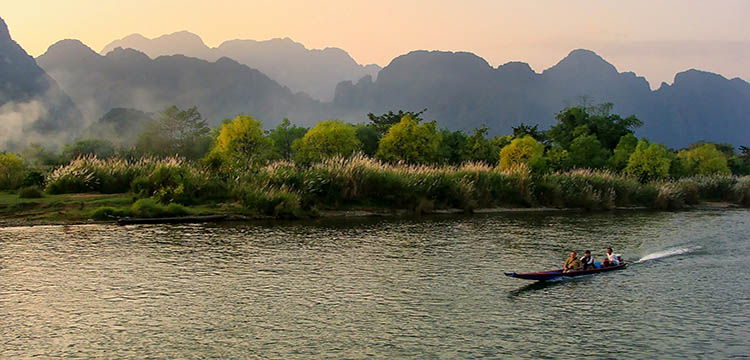
Vang Vieng
Vang Vieng is a small town is situated 150 km from Vientiane. The town lies along the scenic curve in Nam Song River and been a popular destination among backpackers, it is also considered as the little Khaosan Road of Laos. Vang Vieng has a picturesque landscape with striking karst limestone mountains, caves and ancient temples that can be explored.
Within the town of Vang Vieng are numerous monasteries date back the 16th and 17th centuries such as Vat Kang, Vat Chua Pan, Vat Si Vieng Song (Vat That), Vat Phong Phen and the most visited one Vat Si Suman. Surrounding the town are Hmong villages that can be visited and experience first-hand cultural setting of Laotians. Most of the travelers spend their time biking and strolling along the river banks, exploring the local villages and local villages in the area.
Crossing the Nam Song River via the main bamboo footbridge leads visitor to several caves that can be accessed by foot, bicycle or motorbike. Rough small dirt road winds towards the jungle reaching the base of the limestone karsts.
Pha Tang Mount situated closely to Bane Pan Tang besides Nam Song River. It is a stunning limestone mountain in its unique shape created by nature.
The most interesting attraction in Vang Vieng is the Tham Phu Kham cave. The cave is about 6 km from Vang Vieng situated on the other side of a blue-green stream that can be crossed via sturdy footbridge. Once on the other side a stiff 200 m climb leads to the caves entrance. The cave has no clear marked pathways a torch is needed to navigate the semi-darkness climb down to the reclining Buddha that lies in the main cavern.
Tham Sang another cave to be explored in Vang Vieng is positioned just above the banks of the Nam Song River and about 7 km north of Vang Vieng on the west side of the river. Tham Sang, the Elephant Cave contains stalactite that resembles an elephant. Buddha images are also seen inside the cave.
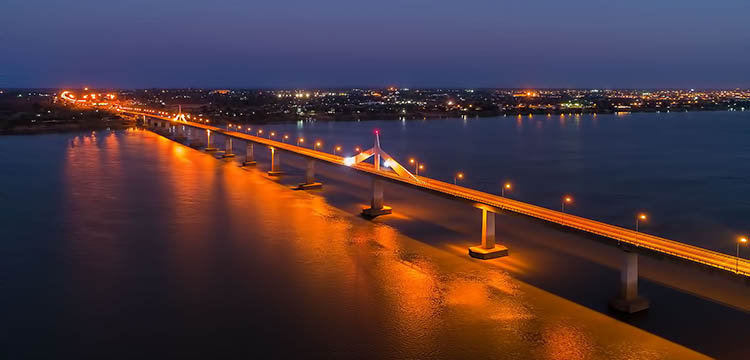
Savannakhet
Lying along the banks of the Mekong River opposite Mukdahan Province in Thailand is Savannakhet Province. Savannakhet is the most populous province in the country and has a total area of 21,774 sq km which stretches the width of Laos from Vietnam to Thailand.
As of 2005, the province population reached 824,662; there are twelve ethnic groups in the province including Tai Dam, Phoutai, Kapo, Kaleung, and Lava. Almost two-thirds of the total population belongs to the Lao Loum ethnic group. The province strategic location serves as a major trading route in the southern part of Laos. The opening of the 1600 m Second Friendship Bridge that connects Savannakhet to Mukdahan creates a direct access to Thailand and opens business opportunities for all economic sectors in Savannakhet.
The town of Savannakhet was established in 1642 by Lao prince, Thao Keosimphali. The Prince brought many families from Ban Phonsim to reside along the bank of the Mekong River. In 1883, during the French occupation Savannakhet had been recognized as a center of administration and commerce in southern Laos, numerous French colonial and Franco-Chinese buildings sprouted in Savannakhet.
The best way to get around the area is by foot though tuk-tuks are also available around the city. In the old quarter of Savannakhet are old French Colonial Structures. This small town along route 13 on the way to Pakse resembles a small French town with comparable structures surrounding a central market place.
The main tourist attractions in the area are the temples. About 15 km north of the Savannakhet along the Seno road lays the second most revered religious place in southern Laos That Ing Hang Temple, a very sacred site for Laotian Buddhist after Wat Phou ruins in Champassak. Built during the reign of King Sikhottabong to commemorate the areas where Buddha rested during his wandering 2500 years ago. The towering stupa features three terraces and a hallow chamber. At the base of the stupa is remarkable collection of Buddha images, relics buried deep beneath the stupa dates back several centuries. Every year, during the month of February or March thousands of devotees gather around the ground of the stupa to pay respect to Buddhism.
Another impressive site that can be seen in Savannakhet province is the 1000 year old ancient Khmer Empire ruins of Vat Heuan Hin, “Temple House Made of Stones”. During 500 AD the shrine was constructed to honor the glory of the Khmer Empire. The area is situated in Ban Dong, Dokmay Songkhone about 65 km south of Savannakhet.
Vat Sayaphoum is the one of the largest and the historic temples in the town of Savannakhet. The temple houses more than 200 monks and novices. The first monastery on the site built in 1542, and by 1896 renovation was done within the area and modern temple architecture reflects around this important center for Buddhist devotees and monks. The temple is a prominent Pali school placed on the banks of the Mekong River.
Another interesting attraction in Savannakhet province is the Dinosaur Museum. The museum is situated on Thanon Khanthaburi in Ban Sayaphoum, Savannakhet province. The Dinosaur Museum exhibits the Dinosaur fossils and data, about the four kinds of dinosaurs excavated in the region of Ban Tangvai 120 km east of the province of Savannakhet such as Saurpodes, Theropode, Iguanodon, and Psittacosaurus. In 1936, a French geologist Josue Heilman Hoffet discovered deposits of fossils of dinosaurs and fermur; he collected a number of other bones in the area as a proof of existence of prehistoric Laos. The collection of Hoffet were rediscovered by a joint Lao-French paleontological team in 1990 and discovered new remains of dinosaurs in the area which are all being displayed in the Dinosaur Museum.
A Classic wooden structures pillar of Ho Tai Pi Dok Library in Nong Lamchan village south of the Savannakhet contains a collection of ancient palm leaves manuscripts written in the ancient Bali-Sanskrit and Lao alphabets is another place to see in Savannakhet.
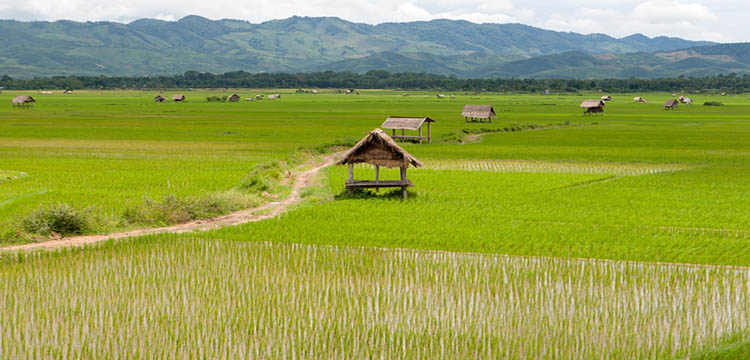
Luang Namtha
Luang Namtha is a mountainous province in the northwestern part of the country bordering Myanmar to the northwest, China to the north, Bokeo province to the southwest and Odomxay to the east. The province has a total area of 9,325 sq km and consist of five districts – the capital city Luang Namtha, Nalae, Long, Sing and Vieng Phoukha.
In 2005, the province’s total population was about 152 285 with majority of its population living in rural areas. Luang Namtha is an ethnically diverse province with more than 20 ethnic groups residing here making it the most diverse province in the country. The villagers’ primary employment activity is agriculture.
To navigate Luang Namtha local transport such as tuk-tuks, minibuses are easily hire and not too expensive. Short trips can be navigated by foot, bicycle as well as motorbikes. Maps can be access in the guesthouses or can be purchase at shops within the city.
Luang Namtha’s tourism has expanded over the past years due to the large response of tourists toward the province’s cultural, ecological, and adventure tourism. Luang Namtha Museum is a good place to get oriented to the province’s rich culture and natural resources before exploring the place. The museum exhibits a significant collection of indigenous clothing and artifacts, currency from colonial times, religious artifacts, agricultural tools, weapons as well as Khmu bronze drums.
There are numerous handicrafts stores within the area. Handicrafts cooperatives exist to provide livelihood to the villagers. The Black Tai village is known for their production and weaving of silks while Akha women produce traditional silver jewelry, beaded necklaces and bracelets, the Hmong women sell embroidery, bags and clothing the and Lanten ethnic group produces bamboo paper, indigo clothing and carved objects.
There are a number of temples as well as ruin within the area. Vat Luang Korn is one of the largest temples constructed in 1892, it is situated 7km from the city center.
Within the old town of the Namtha are the remains of the ancient city and temple of Khou Vieng and Vat Mahapot. Visiting the place will give an insight about the little known history of a civilization inhabited Vieng Phoukha in early 15th century. That Phoum Phouk was the most famous and respected pagoda in Namtha District that was built in 1628. However, this structure was destroyed during the Second Indochina War and in 2003 a new stupa was constructed beside the ruins of the old.
The caves in the area are also worth seeing. A few meters away from the road of Luang Namtha and 12 km north of Vieng Phoukha is Nam Aeng Cave. Within the cave is a small stream runs from the mouth of the cave. Sam Hee See Nom Cave once kept a sacred Buddha which has now been despoiled, the cave served as a hide-out and meeting place during the revolution. In Phou Prasat is a labyrinth of caves filled with bats. Kao Rao Cave is a stunning tunnel-like formation near Nam Eng Village in Vieng Phoukha.
Visiting the Ethnic Villages is main reason why Luang Namtha tourism expands. Each district in Luang Namtha has distinctive ethnic composition. Some ethnic groups residing in Luang Namtha are Tai Da (Black Tai), Tai Yuan (Kalom), Tai Deng (Red Tai), White Tai, Tai Leu, Khmu, Oo, Lao Bit, Lanten, Mien, Hmong, Akha, Lahu, Phou Noi and Samtao. Ethnic villages usually home to about thirty families. The most visited ethnic groups are Akha, Khmu, Yao and Lanten. When visiting a village courtesy should be shown. A friendly gesture and genuine concern can make ones experience enjoyable and unforgettable. It is impolite to openly refuse the thing being offered by the host. Touching religious and spiritual significance is inappropriate unless suggested by the hosts.
Nam Ha Ecotourism Project is another main attraction in the province of Luang Namtha. Founded by the New Zealand government and UNESCO, the project attracts tourists and direct them to activities that are culturally and environmentally sensitive. Nam Ha National Protected Area (NPA) covers about 2 230 sq km or 24% of the province of Luang Namtha. The Nam Ha NPA is a home to about 37 species of mammals and 65 species of fish and about 300 species of birds. The boat trips down the protected area offer a remarkable bird watching opportunity. Wildlife trekking, hiking, kayaking, biking are some of the activities within the NPA.
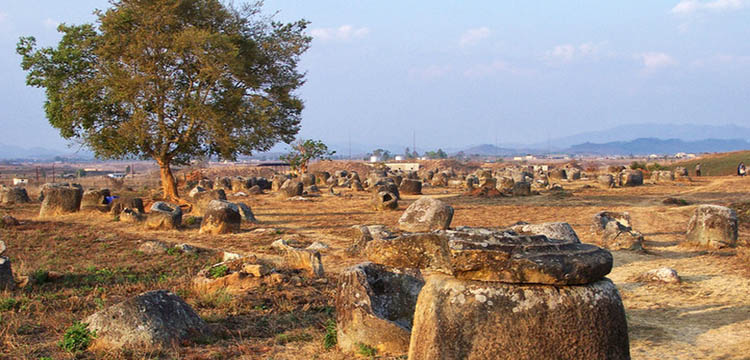
Plain of Jars
In the midway between the capital Vientiane and Luang Prabang lies a mountainous limestone karst area of Xieng Khouang Province. The province has almost 200 000 population including the large proportions of ethnic minority people mostly Hmong and Vietnamese.
Plain of Jars is an intriguing archaeological site deep in the mountains of Xieng Khouang. Plain of Jars has a bizarre collection of mysterious antique stone jars scattered across the war-scarred countryside. The jars are presumed to be one of the oldest archeological sites in Southeast Asia. The origin of these jars is still obscure as well as its composition. Some jars are made from sandstone, granite, conglomerate while others are made from limestone.
Plain of Jars considered as the last traces of ancient civilization positioned next to 30 years crater and unexploded US ordinance left by the ultimate aerial salvo of all time. There are more than 60 jar sites that have been found and identified on the promontories and mountain ridges. However, only three sites are opened for visitors; the Thong Hai Hin (Site 1), Hai Hin Phu Salato (Site 2), and the Hai Hin Laat Khai (Site 3). A number of sites contain more than 250 jars. These jars weigh about 14 tons and height ranging from 1 to 3m. The tallest jar is about 3m in height and over a meter in width. While most of the jars are undecorated, a few have carved of human bas-relief, figures or faces. The circular stone discs, assumed to be the lids adjoining the jars are also carved with image of human and animals particularly monkeys or tigers.
In 1930’s French archeologist Madeleine Coloni, did an extensive study on jars of Xieng Khouang. According to the research made the plain of jars were created by a civilization that thriven between 300 BC and 300 AD. Artifacts collected during the study were bronze and iron tools, bracelets, cowry shells and glass beads and charred human bone fragments, supporting the hypothesis that these were funeral urns carved by an extinct Bronze Age people.
In 1994 excavation lead by Eiji Nitta of Kagoshima University, a carving of a human figure on the side of the jar was sited, this is the first anthropomorphic image recorded at the area. Pits being covered by seven flat stones were also discovered, six of of the seven pits contain human bones and one contains two-foot-tall burial jar with small pieces of bone and teeth inside. The discovered pits were suggested to be sites of secondary burial (corpse is left to decompose into it essence).
The Plains of Luang Prabang is a shocking revelation of what happened in the course of the Secret War in Laos during 1964-1973. During the nine years of war there were more than 580 000 bombing missions over Laos. Over two tons of bomb per person were released, which turned Laos into the most bombed country in the history, eventually destroyed Xieng Khouang. More than 30% of the cluster bombs units (CBU’s) and unknown percentage of other types of ordinance failed to explode during the war thus, it continues to injure and kill hundreds of people every year.
The administration of Xiang Khouang Province, government of Lao PDR and UNESCO started a multi-yearly phrased programme to safeguard and develop the Plain of Jars. Clearing the large quantity of the unexploded ordinances (UXOs) is needed in order to make it possible for exploration and appreciation of the jars without fear on landmines. In order to protect the safety of the visitors mark paths are placed, since the UXO still hunt the region.




